When Form Follows Function: Q&A with Scott Surine
By Jonathan Moody
Bass Musician Magazine
December 1, 2014
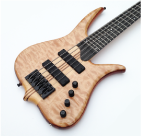
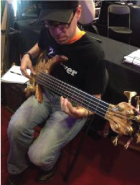
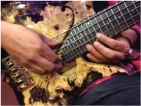
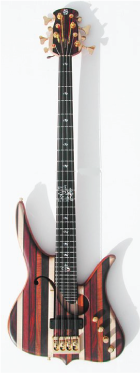
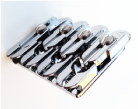
The concept of an object being created based upon the intended purpose is always a noble feat, but when you then bring in aesthetics and marketing, somehow that original concept is not what you had intended, and you finally understand the phrase, “A camel is a horse designed by committee.” Especially for this musician, one of the main functions involved is comfort when playing in a seated position (since the bulk of my gigs are in the studio or under the stage). So it was wonderful to meet Scott Surine and Roberto Bernardeinello of Surine Basses this past November at Bass Player LIVE! in Hollywood, CA and play some amazing basses. After chatting with both about design, function and the like, we exchanged business cards and I wrote up some more questions.
With a design background, how did you marry the aesthetic choices (based on design) with the utility choices (based on players needs) into Surine?
I am a firm believer in “Form Follows Function”. My objective, early on, was to build a brand based on this principle, where aesthetics are seamlessly fused with functionality. Simple, clean lines to create a contemporary and timeless design, easy access to the fingerboard’s upper register, reducing the size of the headstock to ensure optimum balance regardless of string configuration, and an intuitive controls layout. Our standard layout configuration is: Individual Volumes, Concentric Bass and Treble, Mid Boost/Cut. Although we offer the option of a Master Volume and Pickup Blend, I feel the individual volume configuration dramatically increases the sonic versatility of the instrument. For example: on an indoor gig, I might have only the bridge pickup on, but on an outdoor gig, I might add 50% of the neck pickup to add low-end on an outdoor stage.
How have ergonomics (especially when playing in the seated position) affected your design focus?
Great question. I remember, when designing the first of the bodystyles, the Affinity, I wanted to make sure that, when sitting, the user wouldn’t be hunched over because the instrument’s waist was too close to the centerline of the instrument. I actually cut out a couple of foamcore mockups to see which felt better. A few years into the business, additional bodystyles became available. The Regency, then the Quest, became very popular – perhaps due to their appearance. But, both these versions incorporate a lower waist that is positioned more forward (towards the neck) than its predecessors which significantly helps balance while seated. This became especially apparent when 7-strings were almost becoming the most requested order.
Tell me how the Regency concept came into being, and any issues that had to be addressed to bring it to life?
The Regency is a very distinctive instrument. Back when MTV Unplugged was very popular, I remember thinking “I need to have a semi-hollow design that would t right in on this show”. So, I sat at my coffee table for several hours (legs crossed and cramping up) and sketched . . . and sketched . . . until a whole new shape started to emerge. I wanted to come up with a design that hadn’t been done before. So, instead of a variation of an “F-Hole” on either side of the through-neck construction, I chose to have the sound cavity carve into the neck and pass into each wing, which are mostly hollowed out. Aesthetically speaking, I wanted the soundhole to start geometrically as a perfect circle then transition into a more organic shape. Extending the range of the fingerboard to a major 6th beyond the second octave and resolving its edge so that it was part of the design of the soundhole completed the overall look. It stayed as a drawing for awhile. I brought it to my very first NAMM show (I believe it was January of ’96) and when approached by an attendee, Vik Momjian, asking If I had any 6-string models that would weigh around 6 pounds, I showed him the drawing and stated I wasn’t sure what it would weigh, but would certainly be less than a solid body bass. After some dialogue and negotiations, Vik agreed to order both a fretted and fretless 6-string Regency. These became the very first Regencies and, without his willingness to try something untested, the Regency may never have come to fruition. For this, I will always be thankful to Vik.
As for any issues, the first handful of Regencies have the adjusting nuts to the trussrods located just beyond the end of the fingerboard. Although this works, they are a little challenging to access without bumping the edge of the soundhole. After the Quest (the solid body equivalent) was introduced, I decided to try something new – a removable extension to the fingerboard in which the trussrod access cavities were concealed underneath. Unsure whether this idea would really work and that it wouldn’t affect the playability beyond the 24th fret (where it is removable), we tried it on a Quest that was for my own personal use. With a successful prototype on hand, I decided to incorporate the same concept into the design of the Regency.
What is your favorite instrument that you’ve built to date and why?
My favorite instrument built to date may very well be what we refer to as the “Rainbow Regency,” for a customer in Montreal, Canada. This instrument is the main image on the Surine Basses Facebook page. The challenge of having the 39-piece laminated top align with the laminates on the back, the Lion of Judah 12th fret inlay and related motif inlays elsewhere on the fingerboard, the custom 8-string bridge by Hipshot, the redesigned headstock to accommodate all 8 tuners, two of which were D-tuners, the “invisible” thumbrest, all led to an adventurous journey of detail and intricacy.
Also, what’s your favorite instrument that you haven’t built and why?
There is a concept instrument that I have yet to build and am not yet ready disclose its unique functionality at this time.
The Sonova bridge seems a very logical progression to your bass building. How has the reception been among players and other builders?
The Sonova bass bridge has been very well received. For all those who have asked for this upgrade, have been very impressed with its stylish appearance, versatile string spacing options, and amount of sustain achieved from a bridge machined from solid brass. At this point, it is an upgrade option due to its high unit cost (resulting from small production runs). I plan to look into ways to have it produced in large enough quantities to get the unit cost down. It does however, add an elegant and uniquely refined look to our instruments and hope to make it a standard on all our basses in the future.
Thank you to all who have taken the time to read this interview, and thank you Jon for the opportunity to tell a bit of the Surine Basses story.
